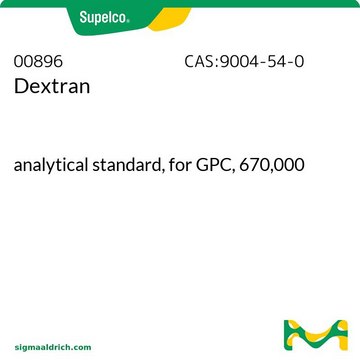8.18892
Polyethylenglykol
35000, (stabilised with 2-tert-butyl-4-methoxyphenol) for synthesis
Synonym(e):
Poly(ethylenglykol), Polyglycol, Polyethylenoxid, Polyoxyethylen, PEG 35000, PEG
About This Item
Empfohlene Produkte
Dampfdruck
<0.01 hPa ( 20 °C)
Qualitätsniveau
Form
liquid
Selbstzündungstemp.
>320 °C
Wirksamkeit
28000 mg/kg LD50, oral (Rat)
>20000 mg/kg LD50, skin (Rabbit)
pH-Wert
5-7 (20 °C, 100 g/L in H2O)
mp (Schmelzpunkt)
60-65 °C
Übergangstemp.
flash point 260 °C
Löslichkeit
500 g/L
Dichte
1.2 g/cm3 at 20 °C
Schüttdichte
400‑500 kg/m3
Lagertemp.
2-30°C
SMILES String
C(CO)O
InChI
1S/C2H6O2/c3-1-2-4/h3-4H,1-2H2
InChIKey
LYCAIKOWRPUZTN-UHFFFAOYSA-N
Suchen Sie nach ähnlichen Produkten? Aufrufen Leitfaden zum Produktvergleich
Anwendung
- Hierarchisch strukturierte Kieselgel-Monolithen für die Herstellung von Mikro-Bioreaktoren.
- Mikro-nanostrukturierte PEG-DA(PEG-Diacrylat)-Hydrogele für biomedizinische Anwendungen.
Es kann auch wie folgt eingesetzt werden:
- Als Template zur Herstellung einer mikro-/mesoporösen Kieselgelstruktur mittels Sol-Gel-Verfahren.
- Als Stabilisierungsmittel bei der Synthese von Metallnanopartikeln.
Hinweis zur Analyse
Schmelzbereich (unterer Wert): ≥ 62 °C
Schmelzbereich (oberer Wert): ≤ 67 °C
Durchschnittliche Molekülmasse: 28.000–38.000
Identität (IR): entspricht
Lagerklassenschlüssel
10 - Combustible liquids
WGK
WGK 1
Flammpunkt (°F)
281.5 °F - closed cup
Flammpunkt (°C)
138.6 °C - closed cup
Analysenzertifikate (COA)
Suchen Sie nach Analysenzertifikate (COA), indem Sie die Lot-/Chargennummer des Produkts eingeben. Lot- und Chargennummern sind auf dem Produktetikett hinter den Wörtern ‘Lot’ oder ‘Batch’ (Lot oder Charge) zu finden.
Besitzen Sie dieses Produkt bereits?
In der Dokumentenbibliothek finden Sie die Dokumentation zu den Produkten, die Sie kürzlich erworben haben.
Kunden haben sich ebenfalls angesehen
Unser Team von Wissenschaftlern verfügt über Erfahrung in allen Forschungsbereichen einschließlich Life Science, Materialwissenschaften, chemischer Synthese, Chromatographie, Analytik und vielen mehr..
Setzen Sie sich mit dem technischen Dienst in Verbindung.


